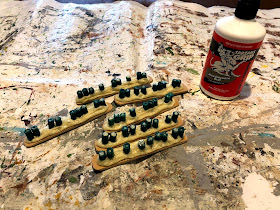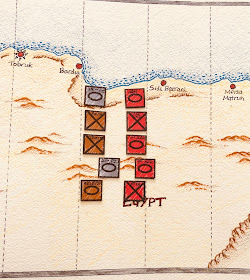As a break from my WW2 Western Desert campaign and associated games. I decided to get out my old Peter Laing AWI armies for a game (or two) and to test out some morale rule ideas which are bolted onto One-Hour Wargaming (OHW) horse and musket rules.
As regular readers know I quite like using D3 dice and often change various OHW rules from using D6 to using D3. So rather than using D6-2, D6, or D6+2, I use D3-1, D3 and D3+1 for hits, and cover reduces the score by 1 rather than halving.
But first the tracking of hits. In the games I was tracking hits on D6 dice, but decided I would rather track units to 8 hits using counters. They are less obtrusive than dice, particularly with 15mm figures. I cut out a number of squares from MDF, painted them green, on one side numbered each edge 1 to 4, and 5 to 6 on the other side.
When tracking hits the side with the appropriate number is placed against the stand
 |
| Numbers are written on both sides of the counter |
 |
| A unit with 3 hits |
For the AWI games I wanted to make unit elimination less predictable than just using the normal OHW approach of accruing of hits, and have the possibility of earlier unit eliminations or forced unit retirement. The morale rule can cause early eliminations of cavalry, skirmishers and artillery, while line infantry are forced to retire.
The rules are below after a couple of photos from a recent game using the rule modifications.
 |
| Close up of the action |
 |
| A game in progress |
Units
- Infantry (line infantry)
- Grenadier
- Skirmishers (light infantry)
- Cavalry
- Artillery
Sequence of Play
- Movement
- Shooting
- Charges
- Morale and Eliminating units
Movement
- Infantry - 6”
- Artillery - 6” (remain stationary after shooting)
- Skirmishers - 9”
- Cavalry - 12”
Turning: Units may pivot on their central point at the start and/or end.
Woods - Only skirmishers can enter.
Towns - only Infantry & Skirmishers may end a move in a town.
Marsh/Lake - impassable.
Rivers - Can be only crossed via bridges & fords. It takes a full move to cross.
Streams - cannot be crossed by artillery. All other units take a full move to cross.
Difficult terrain - only Infantry & Skirmishers can enter.
Hills - all units can move onto hills.
Interpenetration: only Skirmishers can pass through other units and vice-versa.
Shooting
Units that have moved cannot shoot, and cavalry cannot shoot. The procedure for shooting is as follows:
Check field of fire - units can only shoot at a single unit within 45 degree of their frontal facing side. Units in towns have a 360 degree field of fire.
Measure the range - infantry and skirmishers have a range of 12” and artillery 48”.
Assess hits - units roll a D3 dice when shooting with the following adjustments:
- Infantry - D3
- Grenadier - D3, unless within 6" of target then D3+1
- Artillery - D3-1
- Skirmisher - D3-1
Artillery can fire over other units if positioned on a hill.
Units in towns always shoot D3-1.
Charges
Only cavalry units may charge into combat with the following restrictions:
- Can pivot up to 45 degrees before charging.
- Can only attack a single unit.
Cavalry units roll D3 dice with the following adjustments:
- Minus 1 from the score if the target is uphill.
- Double the hits if attacking the flank or rear of a unit.
After the hits are applied. If the defending unit is not eliminated or fails its morale test, then the cavalry retire 6”.
Morale and Eliminating Units
After all shooting has occurred. Any unit that has taken hits must take morale tests.
Roll 2D6 and if the combined score is greater than the unit’s number of hits, the unit carries on. Otherwise the unit fails its morale test.
Artillery, cavalry or skirmishers failing morale tests are eliminated.
Infantry and grenadiers failing morale must retire 6” away from the attacking unit(s). If their retirement path is blocked they are eliminated.
If infantry and grenadiers are charged by cavalry and fail a morale test they are eliminated.
Units are always eliminated upon taking more than 8 hits.
Whenever a unit is eliminated from shooting by infantry positioned within 6" range. One attacking infantry unit can advance into the vacated space. This represents units using the bayonet and charging in when units start to waver.
Note: If you don't like the use of D3 for hits and prefer the use of D6 for hits. Then the morale rule can work the same way by doubling the score of 2D6




























































